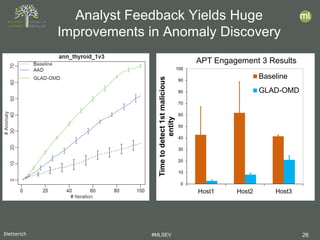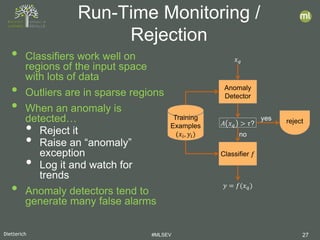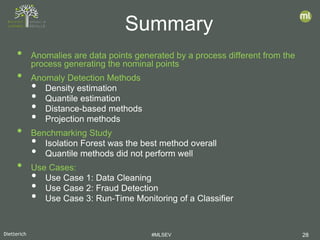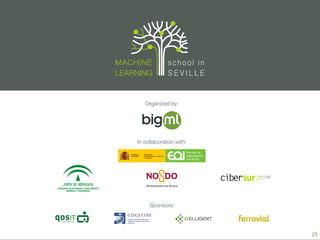MLSEV Virtual. Searching for Anomalies
- 2. Dietterich #MLSEV 2 Searching for Anomalies Tom Dietterich Chief Scientist, BigML, Inc
- 3. Dietterich #MLSEV 3 • Introduction to Anomaly Detection • Anomaly Detection Methods • Density estimation • Quantile estimation • Distance-based methods • Projection methods • Benchmarking Study • Use Cases: • Use Case 1: Data Cleaning • Use Case 2: Fraud Detection • Use Case 3: Run-Time Monitoring of a Classifier Outline
- 4. Dietterich #MLSEV 4 • Goal: Deal with “contaminated data” • Data is a mix of • “nominals”: clean data for our task • “anomalies”: data generated by a distinct process • measurement errors, broken sensors • fraud and criminal behavior • novelty not observed during training Anomaly Detection
- 5. Dietterich #MLSEV 5 • Contaminated Data (no test data) • Single data set contaminated with anomalies • Goal: identify and remove the anomalies before training a classifier • Clean Training/Contaminated Test • Training data has few or no anomalies • Test data will be contaminated by anomalies • Goal: Detect and reject the anomalies • Contaminated Training/Contaminated Test • A combination of the above Three Settings
- 6. Dietterich #MLSEV 6 • Note: Anomalies are typically rare, so having labeled anomaly data is not very useful • Not enough data to train a classifier • Can’t safely assume that test anomalies will be like training anomalies Why Not Supervised Learning?
- 7. Dietterich #MLSEV 7 • Density Estimation • Quantile Methods • Distance-Based Methods • Projection Methods Anomaly Detection Strategies
- 8. Dietterich #MLSEV 8 • Given: • Set of training examples: 𝑥𝑥1, … , 𝑥𝑥𝑁𝑁 • Find: • A probability density model 𝑝𝑝(𝑥𝑥) that assigns high density to the training examples and low density elsewhere • Anomaly Score: • − log 𝑝𝑝(𝑥𝑥) Density Estimation
- 9. Dietterich #MLSEV 9 • Given: • Set of training examples: 𝑥𝑥1, … , 𝑥𝑥𝑁𝑁 • Find: • A probability density model 𝑝𝑝(𝑥𝑥) that assigns high density to the training examples and low density elsewhere • Anomaly Score: • − log 𝑝𝑝(𝑥𝑥) Density Estimation
- 10. Dietterich #MLSEV 10 • Kernel Density Estimation • Places a small kernel function on each data point • Sums these to obtain an overall density • Robustness to contamination • Robust Kernel Density Estimation (Kim & Scott, 2008) uses a Huber-style loss Density Estimation Method By Drleft at English Wikipedia, CC BY-SA 3.0
- 11. Dietterich #MLSEV 11 • Advantages: • Clean theoretical understanding • Many methods: • Kernel density estimation • Ensemble of Gaussian Mixture Models • Deep density estimation • Disadvantages: • General density estimation requires large amounts of data • Sample size grows as exp 𝑑𝑑+4 2 • If the anomaly points form a tight cluster, it will be assigned high probability density (= low anomaly score) Density Estimation
- 12. Dietterich #MLSEV 12 • Find a smooth boundary that encloses fraction 1 − 𝛼𝛼 of the data • Map each data point 𝑥𝑥 into an (𝑁𝑁 − 1)-dimensional space based on its kernel distance to each of the other data points • Surround 1 − 𝛼𝛼 of the points with a surface: • Linear surface: • One-class support-vector machine (OC-SVM) • Hypersphere: • Support-vector data description (SVDD) Quantile Methods 𝐴𝐴 𝑥𝑥𝑞𝑞 = distance outside the boundary
- 13. Dietterich #MLSEV 13 • Advantages: • Amount of training data needed grows as 1 𝜖𝜖2, where 𝜖𝜖 is the accuracy of the 1 − 𝛼𝛼 quantile • Disadvantages: • Requires tuning a kernel function • Algorithms do not scale to large data sets • Does not perform very well for ranking • But see Menon & Willilamson, NeurIPS 2018 for an improvement Quantile Methods
- 14. Dietterich #MLSEV 14 • Choose a distance metric ‖𝑥𝑥𝑖𝑖 − 𝑥𝑥𝑗𝑗‖ between any two data points 𝑥𝑥𝑖𝑖 and 𝑥𝑥𝑗𝑗 • 𝐴𝐴(𝑥𝑥) = anomaly score = distance to 𝑘𝑘-th nearest data point • Points in empty regions of the input space are likely to be anomalies • Local Outlier Factor (LOF): • Normalize by distance of each neighbor to their 𝑘𝑘 nearest neighbors Distance-Based Methods
- 15. Dietterich #MLSEV 15 • Advantages: • Easy to understand • Easy to tune • Perform quite well • Disadvantages • Fail when the anomalies form tight clusters • Naïve implementation requires computing all pairwise distances (time proportional to 𝑑𝑑𝑑𝑑2 ) • Must store the training instances Distance-Based Methods
- 16. Dietterich #MLSEV 16 • Construct a fully random binary tree • choose attribute 𝑗𝑗 at random • choose splitting threshold 𝜃𝜃1 uniformly from min 𝑥𝑥⋅𝑗𝑗 , max 𝑥𝑥⋅𝑗𝑗 • until every data point is in its own leaf • let 𝑑𝑑(𝑥𝑥𝑖𝑖) be the depth of point 𝑥𝑥𝑖𝑖 • repeat 100 times • let 𝑑𝑑̅(𝑥𝑥𝑖𝑖) be the average depth of 𝑥𝑥𝑖𝑖 • 𝐴𝐴 𝑥𝑥𝑖𝑖 = 2 − 𝑑𝑑� 𝑥𝑥𝑖𝑖 𝑟𝑟 𝑥𝑥𝑖𝑖 • 𝑟𝑟(𝑥𝑥𝑖𝑖) is the expected depth Isolation Forest [Liu, Ting, Zhou, 2011] 𝑥𝑥⋅𝑗𝑗𝑥𝑥⋅𝑗𝑗 > 𝜃𝜃1 𝑥𝑥⋅2 > 𝜃𝜃2 𝑥𝑥⋅8 > 𝜃𝜃3 𝑥𝑥⋅3 > 𝜃𝜃4 𝑥𝑥⋅1 > 𝜃𝜃5 𝑥𝑥𝑖𝑖
- 17. Dietterich #MLSEV 17 • Goal: Compare published algorithms on a robust collection of benchmarks • Previous comparisons suffered from small size and/or proprietary data sets Benchmarking Study • Density-Based Approaches – RKDE: Robust Kernel Density Estimation (Kim & Scott, 2008) – EGMM: Ensemble Gaussian Mixture Model (our group) • Quantile-Based Methods – OCSVM: One-class SVM (Schoelkopf, et al., 1999) – SVDD: Support Vector Data Description (Tax & Duin, 2004) [Emmott, Das, Dietterich, Fern, Wong, 2013; KDD ODD-2013] [Emmott, Das, Dietterich, Fern, Wong. 2016; arXiv 1503.01158v2] • Neighbor-Based Methods – LOF: Local Outlier Factor (Breunig, et al., 2000) – ABOD: kNN Angle-Based Outlier Detector (Kriegel, et al., 2008) • Projection-Based Methods – IFOR: Isolation Forest (Liu, et al., 2008) – LODA: Lightweight Online Detector of Anomalies (Pevny, 2016)
- 18. Dietterich #MLSEV 18 • Select 19 data sets from UC Irvine repository • Choose one or more classes to be “anomalies”; the rest are “nominals” • Manipulate • Relative frequency • Point difficulty • Irrelevant features • Clusteredness • 20 replicates of each configuration • Result: 25,685 Benchmark Datasets Benchmarking Methodology
- 19. Dietterich #MLSEV 19 • AUC: Area Under the ROC Curve • binary decision: Nominal vs. Anomaly • what is the probability that the algorithm correctly ranks a randomly-chosen anomaly above a randomly-chosen nominal point? • We measure log 𝐴𝐴𝐴𝐴𝐴𝐴 1−𝐴𝐴𝐴𝐴𝐴𝐴 • LIFT: Ratio of precision of algorithm to precision of random guessing • Related to Average Precision (AP) • We measure log 𝐴𝐴𝐴𝐴 𝐸𝐸[𝐴𝐴𝐴𝐴] Evaluation Metrics
- 20. Dietterich #MLSEV 20 0 0.2 0.4 0.6 0.8 1 1.2 iforest egmm lof rkde abod loda ocsvm svdd ChangeinMetricwrtControl Dataset Algorithm logit(AUC) log(LIFT) Anomaly Detection Benchmark Results iForest was best; quantile methods were worst; all others approximately equal
- 21. Dietterich #MLSEV 21 • High-dimensional spaces are inherently difficult • Can we assume the data live in a lower-dimensional subspace? • Image and video data • Need to discover the lower-dimensional space • Promising directions • Auto-encoders and generative models (VAE, RAE, BiGAN) • Neural Rendering Model • Extending existing methods to work with time series Anomaly Detection Challenges
- 22. Dietterich #MLSEV 22 • Data Cleaning • Fraud Detection • Run-time Monitoring • Guillem will conduct a hands-on session later today Anomaly Detection Use Cases
- 23. Dietterich #MLSEV 23 • Approach • Fit an anomaly detector to your training data • Examine the points with high anomaly scores and remove suspicious points • Visualization is an important tool Data Cleaning
- 24. Dietterich #MLSEV 24 • Approach • Clean your training data as best you can • Train the anomaly detector • Score new transactions • Examine the anomalies in descending order and initiate investigations as appropriate Fraud Detection Data Anomaly Detection Ranked Candidates Convince Analyst? Launch Investigation no yes
- 25. Dietterich #MLSEV 25 • Approach • Show top-ranked candidate to the analyst • Analyst labels candidate • Label is used to update the anomaly detector Incorporating Analyst Feedback Data Anomaly Detection Top-Ranked Candidate Convince Analyst? Launch Investigation no yesAAD [Das, et al, ICDM 2016] GLAD-OMD [Siddiqui, et al., KDD 2018]
- 26. Dietterich #MLSEV 26 Analyst Feedback Yields Huge Improvements in Anomaly Discovery 0 10 20 30 40 50 60 70 80 90 100 Host1 Host2 Host3 Timetodetect1stmalicious entity Baseline GLAD-OMD APT Engagement 3 Results
- 27. Dietterich #MLSEV 27 • Classifiers work well on regions of the input space with lots of data • Outliers are in sparse regions • When an anomaly is detected… • Reject it • Raise an “anomaly” exception • Log it and watch for trends • Anomaly detectors tend to generate many false alarms Run-Time Monitoring / Rejection 𝑥𝑥𝑞𝑞 Anomaly Detector 𝐴𝐴 𝑥𝑥𝑞𝑞 > 𝜏𝜏? Classifier 𝑓𝑓 Training Examples (𝑥𝑥𝑖𝑖, 𝑦𝑦𝑖𝑖) no 𝑦𝑦 = 𝑓𝑓(𝑥𝑥𝑞𝑞) yes reject
- 28. Dietterich #MLSEV 28 • Anomalies are data points generated by a process different from the process generating the nominal points • Anomaly Detection Methods • Density estimation • Quantile estimation • Distance-based methods • Projection methods • Benchmarking Study • Isolation Forest was the best method overall • Quantile methods did not perform well • Use Cases: • Use Case 1: Data Cleaning • Use Case 2: Fraud Detection • Use Case 3: Run-Time Monitoring of a Classifier Summary
- 29. Dietterich 29


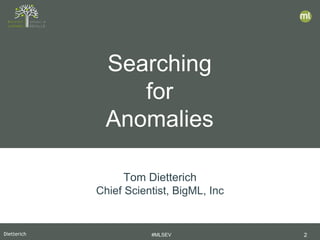
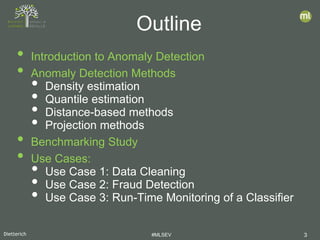
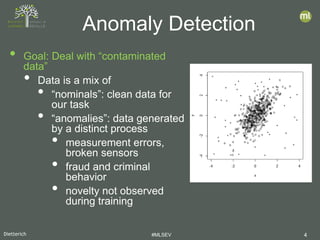
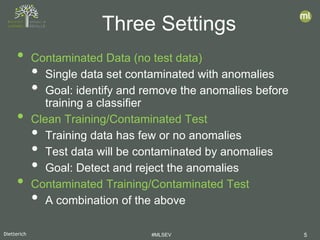
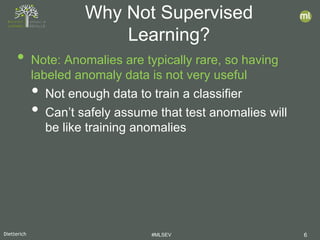
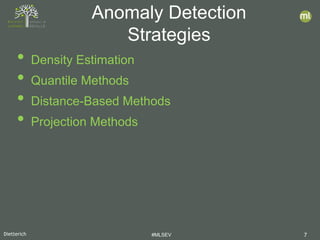
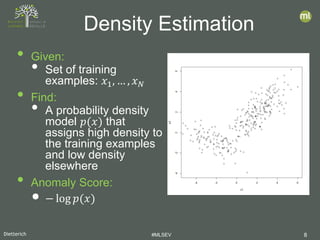
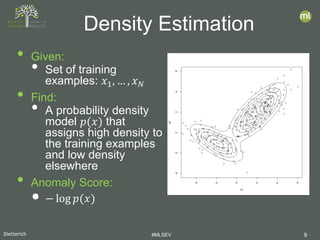
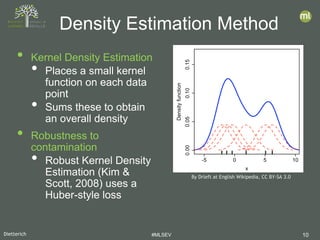
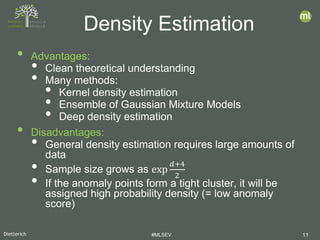

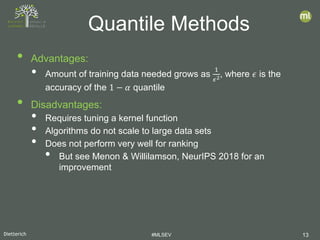
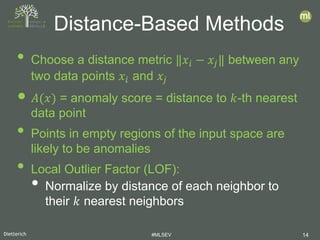
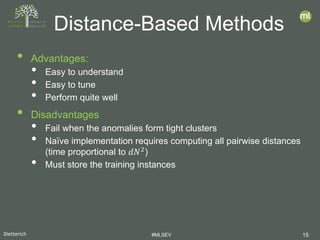
![Dietterich #MLSEV 16
• Construct a fully random binary tree
• choose attribute 𝑗𝑗 at random
• choose splitting threshold 𝜃𝜃1
uniformly from
min 𝑥𝑥⋅𝑗𝑗 , max 𝑥𝑥⋅𝑗𝑗
• until every data point is in its
own leaf
• let 𝑑𝑑(𝑥𝑥𝑖𝑖) be the depth of point 𝑥𝑥𝑖𝑖
• repeat 100 times
• let 𝑑𝑑̅(𝑥𝑥𝑖𝑖) be the average depth of
𝑥𝑥𝑖𝑖
• 𝐴𝐴 𝑥𝑥𝑖𝑖 = 2
−
𝑑𝑑� 𝑥𝑥𝑖𝑖
𝑟𝑟 𝑥𝑥𝑖𝑖
• 𝑟𝑟(𝑥𝑥𝑖𝑖) is the expected depth
Isolation Forest [Liu, Ting, Zhou, 2011]
𝑥𝑥⋅𝑗𝑗𝑥𝑥⋅𝑗𝑗 > 𝜃𝜃1
𝑥𝑥⋅2 > 𝜃𝜃2 𝑥𝑥⋅8 > 𝜃𝜃3
𝑥𝑥⋅3 > 𝜃𝜃4 𝑥𝑥⋅1 > 𝜃𝜃5
𝑥𝑥𝑖𝑖](https://image.slidesharecdn.com/mlsev20bigmltomdietterichanomalies-200331101723/85/MLSEV-Virtual-Searching-for-Anomalies-16-320.jpg)
![Dietterich #MLSEV 17
• Goal: Compare published algorithms on a robust collection of benchmarks
• Previous comparisons suffered from small size and/or proprietary data
sets
Benchmarking Study
• Density-Based Approaches
– RKDE: Robust Kernel Density
Estimation (Kim & Scott, 2008)
– EGMM: Ensemble Gaussian Mixture
Model (our group)
• Quantile-Based Methods
– OCSVM: One-class SVM (Schoelkopf,
et al., 1999)
– SVDD: Support Vector Data
Description (Tax & Duin, 2004)
[Emmott, Das, Dietterich, Fern, Wong, 2013; KDD ODD-2013]
[Emmott, Das, Dietterich, Fern, Wong. 2016; arXiv 1503.01158v2]
• Neighbor-Based Methods
– LOF: Local Outlier Factor (Breunig, et
al., 2000)
– ABOD: kNN Angle-Based Outlier
Detector (Kriegel, et al., 2008)
• Projection-Based Methods
– IFOR: Isolation Forest (Liu, et al.,
2008)
– LODA: Lightweight Online Detector of
Anomalies (Pevny, 2016)](https://image.slidesharecdn.com/mlsev20bigmltomdietterichanomalies-200331101723/85/MLSEV-Virtual-Searching-for-Anomalies-17-320.jpg)
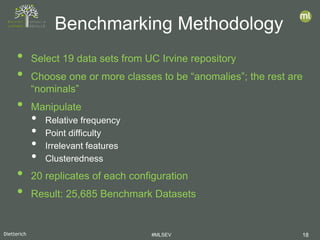
![Dietterich #MLSEV 19
• AUC: Area Under the ROC Curve
• binary decision: Nominal vs. Anomaly
• what is the probability that the algorithm correctly ranks a
randomly-chosen anomaly above a randomly-chosen nominal
point?
• We measure log
𝐴𝐴𝐴𝐴𝐴𝐴
1−𝐴𝐴𝐴𝐴𝐴𝐴
• LIFT: Ratio of precision of algorithm to precision of random
guessing
• Related to Average Precision (AP)
• We measure log
𝐴𝐴𝐴𝐴
𝐸𝐸[𝐴𝐴𝐴𝐴]
Evaluation Metrics](https://image.slidesharecdn.com/mlsev20bigmltomdietterichanomalies-200331101723/85/MLSEV-Virtual-Searching-for-Anomalies-19-320.jpg)
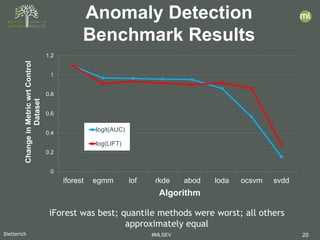
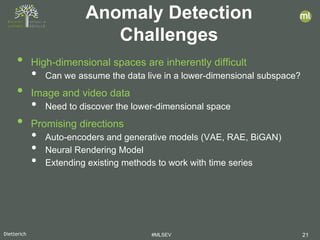
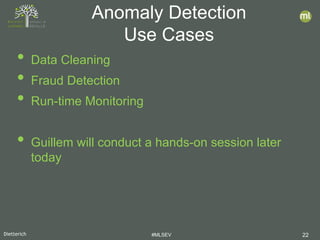
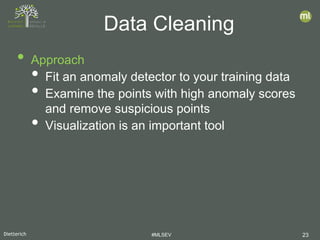
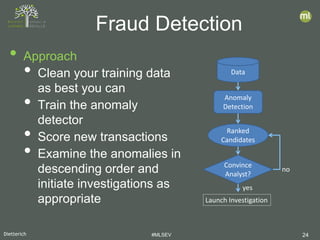
![Dietterich #MLSEV 25
• Approach
• Show top-ranked
candidate to the analyst
• Analyst labels candidate
• Label is used to update
the anomaly detector
Incorporating Analyst
Feedback
Data
Anomaly
Detection
Top-Ranked
Candidate
Convince
Analyst?
Launch Investigation
no
yesAAD [Das, et al, ICDM 2016]
GLAD-OMD [Siddiqui, et al., KDD 2018]](https://image.slidesharecdn.com/mlsev20bigmltomdietterichanomalies-200331101723/85/MLSEV-Virtual-Searching-for-Anomalies-25-320.jpg)
